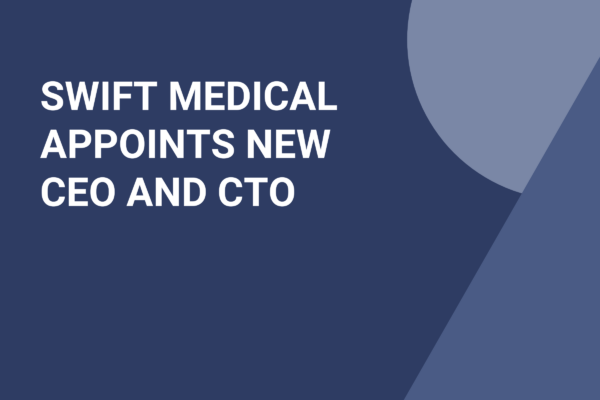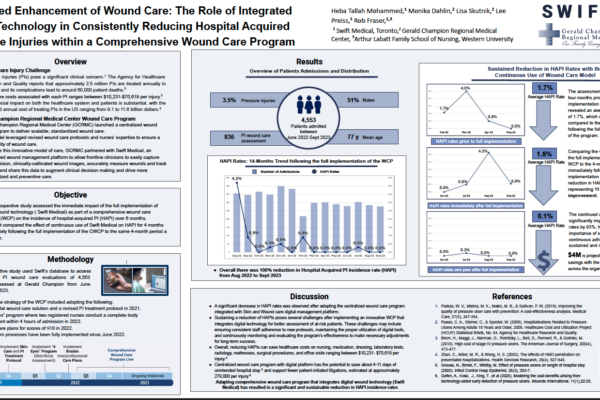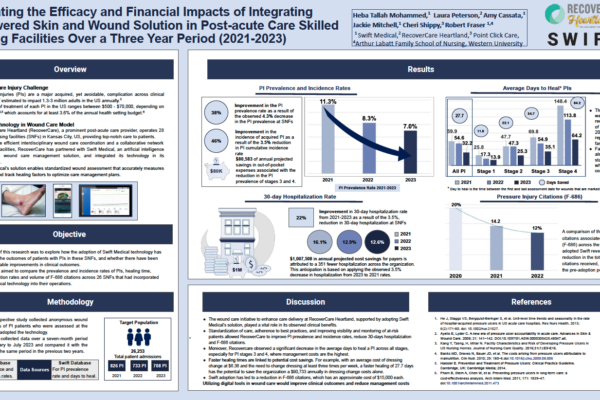We recently had a conversation with Bob Bartlett, M.D., in which he shared his background, his experiences in wound care, and his thoughts about why Swift’s innovative approach to wound care has been so successful. Here are some highlights of our conversation.
You’ve had a lengthy career in healthcare. How did you get started in wound care, and what steps in your career led you to where you are today?
I began my career in Emergency Medicine, running a Level 1 Trauma Center. The hospital was interested in hyperbaric medicine, and when I became the medical director of a hyperbaric program, I started treating a lot of wound care patients. After that, I moved into education, and I worked with several healthcare management companies, helping them expand their business into hospitals across the U.S. My interest in imaging wounds led me to help create BioMatics, a company that used more advanced imaging to look beyond the anatomy of wounds and into their physiology, seeing oxygen and bacteria. I also started a software company, MedaNext, which offered a dynamic platform with a “care path” for patients, leading to improved compliance and efficiency of care.
Putting all of this together, I’m a knowledge engineer. What brought me to Swift was an ongoing interest in what the company was doing. I spoke with the founder, Carlo Perez, and when it was clear that we shared the same vision for healthcare, and specifically wound care, I was excited to join the company.
What prompted you to transition from being a physician to the direct-care delivery and innovation sector?
I have always enjoyed the creative process, and my experiences with patents and startups have been very rewarding. And although medical practice requires problem solving, it is a conservative profession that doesn’t often engender creativity. That said, the future of healthcare delivery is changing rapidly. I have an appetite for innovation and a keen interest in the future, because that is where I plan to spend the rest of my life.
What is the biggest challenge facing hospitals today?
Without doubt, knowledge management. Healthcare is largely a knowledge-based industry. Knowledge is medicine! Why is knowledge management so important? Because healthcare information is currently expanding at a rate that exceeds human capacity. In 1950, for example, medical knowledge doubled in 50 years. By 1980, the doubling time was 7 years. And in 2020, it’s estimated that the doubling time had shrunk to .2 years – just 73 days.
What does this mean in real terms? Physicians who completed their residency training in 2020 will have experienced four doublings in knowledge since they graduated from medical school, and what they learned in the first three years of medical school will be just 12% of what is known in 2020. Knowledge is expanding faster than our ability to assimilate and apply it.
What role do you see “telehealth” and remote wound care playing in the hospital’s environment?
Telemedicine is rapidly becoming a cornerstone of modern healthcare, in large part due to the pandemic. For patients, telemedicine can make it faster, cheaper and safer to get medical care. Patients don’t have to take as much time away from their regular activities, travel to the doctor’s office, pay for parking, or spend time in a room crowded with sick people waiting for their appointment.
Physicians who have adopted telemedicine have found that it saves time. With fewer missed visits, they can care for more patients and potentially increase profits. A growing body of evidence shows that telemedicine is just as good as “in-person” visits for many types of care, and even better for others.
For wound care, telemedicine will have the biggest impact on monitoring post-operative wounds after discharge from the hospital. Two-thirds of all surgical wounds occur between the time of discharge and the first follow-up appointment. Swift can bridge this gap using professional grade, color-corrected imaging to diagnose wound infections at an early stage when oral antibiotics still work. Published studies are unanimous: patients find it convenient and have the peace of mind they are being followed daily. Physicians like it because of the enormous time savings. And hospitals like it because it improves their surgical outcomes when the public views their operative track records using “Hospital Compare.”
What’s the future of wound care in hospitals as you see it? Where is the potential for the greatest improvement?
The acquisition, analysis, transfer and application of information and knowledge is the bedrock of disease management, efficient systems and patient compliance. Patients and providers must know what to do, when to do it, and why they are doing it. There are some incredibly exciting technologies helping to uncover the previously unavailable data in healthcare. It’s exciting to have a part in empowering clinicians and patients.
What makes Swift different?
Swift doesn’t manufacture dressings. They don’t hire healthcare providers. But they deliver two essential commodities: knowledge and information.
Swift uses root cause analysis to give a big-picture understanding of the impact of changes to modes of care, care strategies, your people, your policies, and your protocols. It lets you look at your wound care center at a population level, and you can track results instantly.
Because Swift uses artificial intelligence and machine learning, it can use the same kind of pixel analysis that powers the facial recognition on smartphone and apply it to wounds. It doesn’t just analyze the pattern of the wound and its nuances; it also incorporates metadata and patient information, and it predicts healing (or failure to heal) in a far more accurate way than any of the existing grading and staging systems. It even generates alerts, prompting providers to consider different courses of action. The system incorporates over 120 variables that can all be calculated in a nanosecond. It far exceeds the limits of human memory and capabilities.
One of the guiding principles at Swift is that the company helps providers at the top of their license. In 20 minutes, a nurse at the start of their career can use all of these images and alerts, these analytics and insights, and leverage them to practice as if they had 20 years of experience.
And while Swift is a wound care company, it’s also an imaging company. It all boils down to the HealX marker, which ensures that images deliver true color. This has implications that go well beyond wound care: it is important in dermatology, in forensics, and in lots of different research applications. Swift is truly a visionary company, with products that are already five minutes into the future. And that’s all you need.





